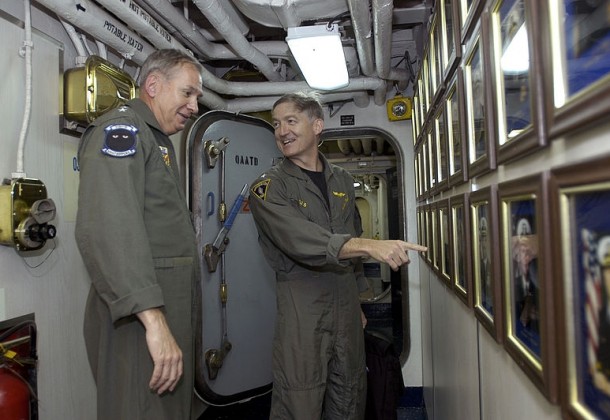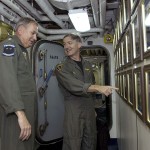At Lockheed Martin, STEM Education Is Personal


As oceanographer of the Navy and former aircraft carrier USS Kitty Hawk (CV 63) Commanding Officer, Rear Adm. Steven John Tomaszeski, left, visited with Commander of the Kitty Hawk Carrier Strike Group Rear Adm. Jamie Kelly in 2004. (U.S. Navy photo)
Lockheed Martin’s commitment to developing interest in STEM education programs and supporting the aspirations of students has become a high priority for this prime defense contractor.
Lockheed Martin has national programs that offer hands-on experiences to students and strategic STEM meetups that bring education and industry together. That energy around STEM initiatives at Lockheed Martin nationally is mirrored here in Southern Maryland.
Steve Tomaszeski is Lockheed Martin’s vice president of Navy-Marine Corps Programs in Lexington Park, MD. When he retired from the Navy and joined Lockheed eight years ago, much of Lockheed’s community support here was going to organizations offering scholarships to children in military families.
“As we evolved in the STEM process at Lockheed, we said one of the best things we had going on here was watching young adults do something in STEM,” he said. “So we at Lockheed decided to swing the rudder a bit away from just pure scholarships to a focus more on kids’ demonstrating technical skills at the high school and college levels. This is what they’re interested in and making a commitment to.”
Among the local programs Lockheed Martin supports are Expanding your Horizons Program (STEM-ming) with The Patuxent Partnership, a program for middle school girls; the MCAA John Glenn Squadron Scholarship fund and the Naval Helicopter Association Scholarship Fund, offering annual merit-based scholarships to promote higher education in STEM; the Association for Unmanned Vehicle Systems (AUVSI) annual student UAS Competition at Webster Field, a partnership with Lockheed Martin ADP Palmdale; the College of Southern Maryland’s Youth in Tech Summit and Robotics Challenge; and the Pax River Navy League’s scholarships for participants in local sea service programs.
Lockheed Martin is also the Founding and Presenting Host of the third annual USA Science & Engineering Festival. The festival is designed to inspire the next generation of scientists and engineers with school programs and nationwide contests, as well as a finale Expo in Washington, D.C. on April 26-27 that includes hands-on activities and performances.
The most powerful influence for an individual’s development as a STEM scholar can be a personal one – as when young adults see someone from their high school or town in a job environment they’d eventually love to be in, Mr. Tomaszeski says.
“When we bring elementary and high school students down to the Integrated Test Force Facility (ITF), where we do F-35 testing, and they see the men and the women who fly and maintain those jets, and if we have one person who went to school here, got a degree and is now flying a jet, that makes more impact than any slide show or any person that student doesn’t know,” he says.
Mr. Tomaszeski says one such example of a local guy who made good and made that kind of impression on young visitors to Pax River is Jim Gigliotti, Lockheed’s Director, F-35C and Navy Program Manager and ITF Deputy for Ship Suitability Test and Verification. He recently relocated to Fort Worth. He’s a proud Ryken graduate, where he competed in golf, wrestling and soccer.
Steve Tomaszeski’s passion for STEM is no surprise. A Jersey boy who credits a rigorous Jesuit education with preparing him to pass admission exams for the U.S. Naval Academy, his interest in science started early, with typical kid stuff (“I shot a rocket off in 7th grade but that was more being mischievous,” he says). At the USNA he majored in physics and oceanography. He became a naval aviator and is a veteran of multiple sea and shore commands. He also served as the 16th Oceanographer/Navigator of the Navy.
Lockheed Martin is a member of The Patuxent Partnership and a partner in TPP’s STEM initiatives. Lockheed Martin is supporting TPP’s second annual STEM-ING event, planned for May 3, 2014, on the campus of St. Mary’s College of Maryland. Building on the success of the 2013 event, this one-day program is designed to introduce up to 140 middle-school girls to local STEM professionals who are positive role models and involve them in knowledge-building workshops that are both practical and fun.
The Patuxent Partnership works intensively on STEM initiatives at the middle school, high school, and college levels. In 2012, TPP announced a $1 million investment to upgrade the physics department at St. Mary’s College. TPP also sponsors events that provide opportunities for students eager to expand their STEM skills, including sponsorship of robotics competitions, aviation courses and summer camp experiences.























I would like to contribute to your STEM effort, in some capacity. I’m retired (from Lockheed Martin in Sunnyvale most recently), after decades of fascinating and productive engineering jobs, including aerospace (Gemini, Shuttle, Milstar, GravityProbeB, etc); medical devices; polymer processing; microelectronics reliability and manufacturing; reduction of lead, ODCs, and asbestos; mentoring young engineers, consulting; lots of patents and publications.
I’ve written a little book (see below) summarizing scores of these assignments, showing how each has been a fun and valuable contribution. I’m hoping it can help exemplify a rewarding technical life and career, and inspire youngsters early on to embrace technical academics and career-pathing.
Note that to me, “technology” does not mean games and gadgets and gossip and tunes; but more serious quests, like autonomous robotics, affordable housing and health maintenance, energy-harvesting, mechanical/environmental modeling, nano-bioengineering, etc using basic engineering physics fundamentals… those elements that will enable the next 50 years of unimaginable new products and environments
If you read the book, you might agree, and might offer it, or me (to discuss or to give presentations), to educators, guidance counselors, and/or parents; as a resource in STEM or related outreach efforts. Feel free to forward this note, as appropriate.
Thanks for the consideration
sincerely
Tom Clifford 650-726-3157
Amazon books “All This Fun and a Paycheck, Too?” Tom Clifford